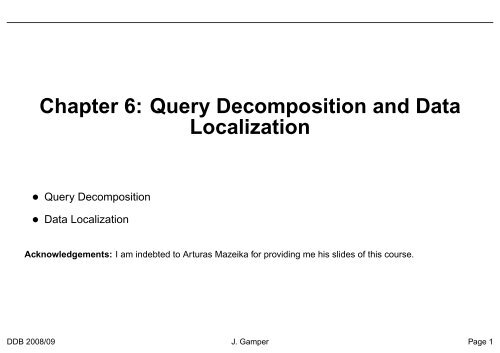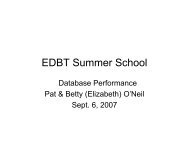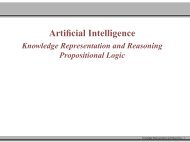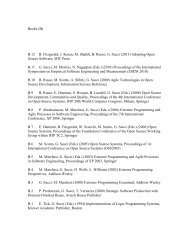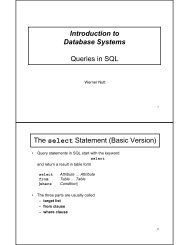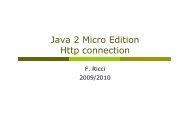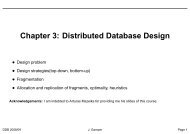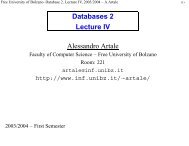Chapter 6: Query Decomposition and Data Localization
Chapter 6: Query Decomposition and Data Localization
Chapter 6: Query Decomposition and Data Localization
You also want an ePaper? Increase the reach of your titles
YUMPU automatically turns print PDFs into web optimized ePapers that Google loves.
<strong>Chapter</strong> 6: <strong>Query</strong> <strong>Decomposition</strong> <strong>and</strong> <strong>Data</strong><br />
<strong>Localization</strong><br />
• <strong>Query</strong> <strong>Decomposition</strong><br />
• <strong>Data</strong> <strong>Localization</strong><br />
Acknowledgements: I am indebted to Arturas Mazeika for providing me his slides of this course.<br />
DDB 2008/09 J. Gamper Page 1
<strong>Query</strong> <strong>Decomposition</strong><br />
• <strong>Query</strong> decomposition: Mapping of calculus<br />
query (SQL) to algebra operations (select,<br />
project, join, rename)<br />
• Both input <strong>and</strong> output queries refer to global relations,<br />
without knowledge of the distribution of<br />
data.<br />
• The output query is semantically correct <strong>and</strong><br />
good in the sense that redundant work is<br />
avoided.<br />
• <strong>Query</strong> decomposistion consists of 4 steps:<br />
1. Normalization: Transform query to a normalized form<br />
2. Analysis: Detect <strong>and</strong> reject ”incorrect” queries; possible only for a subset of relational<br />
calculus<br />
3. Elimination of redundancy: Eliminate redundant predicates<br />
4. Rewriting: Transform query to RA <strong>and</strong> optimize query<br />
DDB 2008/09 J. Gamper Page 2
<strong>Query</strong> <strong>Decomposition</strong> – Normalization<br />
• Normalization: Transform the query to a normalized form to facilitate further processing.<br />
Consists mainly of two steps.<br />
1. Lexical <strong>and</strong> syntactic analysis<br />
– Check validity (similar to compilers)<br />
– Check for attributes <strong>and</strong> relations<br />
– Type checking on the qualification<br />
2. Put into normal form<br />
– With SQL, the query qualification (WHERE clause) is the most difficult part as it<br />
might be an arbitrary complex predicate preceeded by quantifiers (∃, ∀)<br />
– Conjunctive normal form<br />
(p 11 ∨ p 12 ∨ · · · ∨ p 1n ) ∧ · · · ∧ (p m1 ∨ p m2 ∨ · · · ∨ p mn )<br />
– Disjunctive normal form<br />
(p 11 ∧ p 12 ∧ · · · ∧ p 1n ) ∨ · · · ∨ (p m1 ∧ p m2 ∧ · · · ∧ p mn )<br />
– In the disjunctive normal form, the query can be processed as independent<br />
conjunctive subqueries linked by unions (corresponding to the disjunction)<br />
DDB 2008/09 J. Gamper Page 3
<strong>Query</strong> <strong>Decomposition</strong> – Normalization . . .<br />
• Example: Consider the following query: Find the names of employees who have been<br />
working on project P1 for 12 or 24 months?<br />
• The query in SQL:<br />
SELECT ENAME<br />
FROM EMP, ASG<br />
WHERE EMP.ENO = ASG.ENO AND<br />
ASG.PNO = ‘‘P1’’ AND<br />
DUR = 12 OR DUR = 24<br />
• The qualification in conjunctive normal form:<br />
EMP.ENO = ASG.ENO ∧ ASG.PNO = ”P1” ∧ (DUR = 12 ∨ DUR = 24)<br />
• The qualification in disjunctive normal form:<br />
(EMP.ENO = ASG.ENO ∧ ASG.PNO = ”P1” ∧ DUR = 12) ∨<br />
(EMP.ENO = ASG.ENO ∧ ASG.PNO = ”P1” ∧ DUR = 24)<br />
DDB 2008/09 J. Gamper Page 4
<strong>Query</strong> <strong>Decomposition</strong> – Analysis<br />
• Analysis: Identify <strong>and</strong> reject type incorrect or semantically incorrect queries<br />
• Type incorrect<br />
– Checks whether the attributes <strong>and</strong> relation names of a query are defined in the global<br />
schema<br />
– Checks whether the operations on attributes do not conflict with the types of the<br />
attributes, e.g., a comparison > operation with an attribute of type string<br />
• Semantically incorrect<br />
– Checks whether the components contribute in any way to the generation of the result<br />
– Only a subset of relational calculus queries can be tested for correctness, i.e., those<br />
that do not contain disjunction <strong>and</strong> negation<br />
– Typical data structures used to detect the semantically incorrect queries are:<br />
∗ Connection graph (query graph)<br />
∗ Join graph<br />
DDB 2008/09 J. Gamper Page 5
<strong>Query</strong> <strong>Decomposition</strong> – Analysis . . .<br />
• Example: Consider a query:<br />
SELECT ENAME,RESP<br />
FROM EMP, ASG, PROJ<br />
WHERE EMP.ENO = ASG.ENO<br />
AND ASG.PNO = PROJ.PNO<br />
AND PNAME = "CAD/CAM"<br />
AND DUR ≥ 36<br />
AND TITLE = "Programmer"<br />
• <strong>Query</strong>/connection graph<br />
– Nodes represent oper<strong>and</strong> or result relation<br />
– Edge represents a join if both connected<br />
nodes represent an oper<strong>and</strong> relation, otherwise<br />
it is a projection<br />
• Join graph<br />
– a subgraph of the query graph that considers<br />
only the joins<br />
• Since the query graph is connected, the query is semantically correct<br />
DDB 2008/09 J. Gamper Page 6
<strong>Query</strong> <strong>Decomposition</strong> – Analysis . . .<br />
• Example: Consider the following query <strong>and</strong> its query graph:<br />
SELECT ENAME,RESP<br />
FROM EMP, ASG, PROJ<br />
WHERE EMP.ENO = ASG.ENO<br />
AND PNAME = "CAD/CAM"<br />
AND DUR ≥ 36<br />
AND TITLE = "Programmer"<br />
• Since the graph is not connected, the query is semantically incorrect.<br />
• 3 possible solutions:<br />
– Reject the query<br />
– Assume an implicit Cartesian Product between ASG <strong>and</strong> PROJ<br />
– Infer from the schema the missing join predicate ASG.PNO = PROJ.PNO<br />
DDB 2008/09 J. Gamper Page 7
<strong>Query</strong> <strong>Decomposition</strong> – Elimination of Redundancy<br />
• Elimination of redundancy: Simplify the query by eliminate redundancies, e.g.,<br />
redundant predicates<br />
– Redundancies are often due to semantic integrity constraints expressed in the query<br />
language<br />
– e.g., queries on views are exp<strong>and</strong>ed into queries on relations that satiesfy certain<br />
integrity <strong>and</strong> security constraints<br />
• Transformation rules are used, e.g.,<br />
– p ∧ p ⇐⇒ p<br />
– p ∨ p ⇐⇒ p<br />
– p ∧ true ⇐⇒ p<br />
– p ∨ false ⇐⇒ p<br />
– p ∧ false ⇐⇒ false<br />
– p ∨ true ⇐⇒ true<br />
– p ∧ ¬p ⇐⇒ false<br />
– p ∨ ¬p ⇐⇒ true<br />
– p 1 ∧ (p 1 ∨ p 2 ) ⇐⇒ p 1<br />
– p 1 ∨ (p 1 ∧ p 2 ) ⇐⇒ p 1<br />
DDB 2008/09 J. Gamper Page 8
<strong>Query</strong> <strong>Decomposition</strong> – Elimination of Redundancy . . .<br />
• Example: Consider the following query:<br />
SELECT TITLE<br />
FROM EMP<br />
WHERE EMP.ENAME = "J. Doe"<br />
OR (NOT(EMP.TITLE = "Programmer")<br />
AND ( EMP.TITLE = "Elect. Eng."<br />
OR EMP.TITLE = "Programmer" )<br />
AND NOT(EMP.TITLE = "Elect. Eng."))<br />
• Let p 1 be ENAME = ”J. Doe”, p 2 be TITLE = ”Programmer” <strong>and</strong> p 3 be TITLE = ”Elect.<br />
Eng.”<br />
• Then the qualification can be written as p 1 ∨ (¬p 2 ∧ (p 2 ∨ p 3 ) ∧ ¬p 3 )<br />
<strong>and</strong> then be transformed into p 1<br />
• Simplified query:<br />
SELECT TITLE<br />
FROM EMP<br />
WHERE<br />
EMP.ENAME = "J. Doe"<br />
DDB 2008/09 J. Gamper Page 9
<strong>Query</strong> <strong>Decomposition</strong> – Rewriting<br />
• Rewriting: Convert relational calculus query to relational algebra query <strong>and</strong> find an<br />
efficient expression.<br />
• Example: Find the names of employees other<br />
than J. Doe who worked on the CAD/CAM<br />
project for either 1 or 2 years.<br />
• SELECT<br />
FROM<br />
WHERE<br />
AND<br />
AND<br />
AND<br />
ENAME<br />
EMP, ASG, PROJ<br />
EMP.ENO = ASG.ENO<br />
ASG.PNO = PROJ.PNO<br />
ENAME ≠ "J. Doe"<br />
PNAME = "CAD/CAM"<br />
AND (DUR = 12 OR DUR = 24)<br />
• A query tree represents the RA-expression<br />
– Relations are leaves (FROM clause)<br />
– Result attributes are root (SELECT clause)<br />
– Intermediate leaves should give a result<br />
from the leaves to the root<br />
DDB 2008/09 J. Gamper Page 10
<strong>Query</strong> <strong>Decomposition</strong> – Rewriting . . .<br />
• By applying transformation rules, many different trees/expressions may be found that<br />
are equivalent to the original tree/expression, but might be more efficient.<br />
• In the following we assume relations R(A 1 , . . . , A n ), S(B 1 , . . . , B n ), <strong>and</strong> T which is<br />
union-compatible to R.<br />
• Commutativity of binary operations<br />
– R × S = S × R<br />
– R ⋊⋉ S = S ⋊⋉ R<br />
– R ∪ S = S ∪ R<br />
• Associativity of binary operations<br />
– (R × S) × T = R × (S × T)<br />
– (R ⋊⋉ S) ⋊⋉ T = R ⋊⋉ (S ⋊⋉ T)<br />
• Idempotence of unary operations<br />
– Π A (Π A (R)) = Π A (R)<br />
– σ p1(A1) (σ p2(A2) (R)) = σ p1(A1)∧p2(A2) (R)<br />
DDB 2008/09 J. Gamper Page 11
<strong>Query</strong> <strong>Decomposition</strong> – Rewriting . . .<br />
• Commuting selection with binary operations<br />
– σ p(A) (R × S) ⇐⇒ σ p(A) (R) × S<br />
– σ p(A1 )(R ⋊⋉ p(A2 ,B 2 ) S) ⇐⇒ σ p(A1 )(R) ⋊⋉ p(A2 ,B 2 ) S<br />
– σ p(A) (R ∪ T) ⇐⇒ σ p(A) (R) ∪ σ p(A) (T)<br />
∗ (A belongs to R <strong>and</strong> T )<br />
• Commuting projection with binary operations (assume C = A ′ ∪ B ′ ,<br />
A ′ ⊆ A, B ′ ⊆ B)<br />
– Π C (R × S) ⇐⇒ Π A ′(R) × Π B ′(S)<br />
– Π C (R ⋊⋉ p(A ′ ,B ′ ) S) ⇐⇒ Π A ′(R) ⋊⋉ p(A ′ ,B ′ ) Π B ′(S)<br />
– Π C (R ∪ S) ⇐⇒ Π C (R) ∪ Π C (S)<br />
DDB 2008/09 J. Gamper Page 12
<strong>Query</strong> <strong>Decomposition</strong> – Rewriting . . .<br />
• Example: Two equivalent query trees for the previous example<br />
– Recall the schemas: EMP(ENO, ENAME, TITLE)<br />
PROJ(PNO, PNAME, BUDGET)<br />
ASG(ENO, PNO, RESP, DUR)<br />
DDB 2008/09 J. Gamper Page 13
<strong>Query</strong> <strong>Decomposition</strong> – Rewriting . . .<br />
• Example (contd.): Another equivalent query tree, which allows a more efficient query<br />
evaluation, since the most selective operations are applied first.<br />
DDB 2008/09 J. Gamper Page 14
<strong>Data</strong> <strong>Localization</strong><br />
• <strong>Data</strong> localization<br />
– Input: Algebraic query on global conceptual<br />
schema<br />
– Purpose:<br />
∗ Apply data distribution information to the<br />
algebra operations <strong>and</strong> determine which<br />
fragments are involved<br />
∗ Substitute global query with queries on<br />
fragments<br />
∗ Optimize the global query<br />
DDB 2008/09 J. Gamper Page 15
<strong>Data</strong> <strong>Localization</strong> . . .<br />
• Example:<br />
– Assume EMP is horizontally fragmented<br />
into EMP1, EMP2, EMP3 as follows:<br />
∗ EMP1 = σ ENO≤”E3” (EMP)<br />
∗ EMP2 = σ ”E3””E6” (EMP)<br />
– ASG fragmented into ASG1 <strong>and</strong> ASG2 as<br />
follows:<br />
∗ ASG1 = σ ENO≤”E3” (ASG)<br />
∗ ASG2 = σ ENO>”E3” (ASG)<br />
• Simple approach: Replace in all queries<br />
– EMP by (EMP1∪EMP2∪ EMP3)<br />
– ASG by (ASG1∪ASG2)<br />
– Result is also called generic query<br />
• In general, the generic query is inefficient since important restructurings <strong>and</strong><br />
simplifications can be done.<br />
DDB 2008/09 J. Gamper Page 16
<strong>Data</strong> <strong>Localization</strong> . . .<br />
• Example (contd.): Parallelsim in the evaluation is often possible<br />
– Depending on the horizontal fragmentation, the fragments can be joined in parallel<br />
followed by the union of the intermediate results.<br />
DDB 2008/09 J. Gamper Page 17
<strong>Data</strong> <strong>Localization</strong> . . .<br />
• Example (contd.): Unnecessary work can be eliminated<br />
– e.g., EMP 3 ⋊⋉ ASG 1 gives an empty result<br />
∗ EMP3 = σ ENO>”E6” (EMP)<br />
∗ ASG1 = σ ENO≤”E3” (ASG)<br />
DDB 2008/09 J. Gamper Page 18
<strong>Data</strong> <strong>Localization</strong>s Issues<br />
• Various more advanced reduction techniques are possible to generate simpler <strong>and</strong><br />
optimized queries.<br />
• Reduction of horizontal fragmentation (HF)<br />
– Reduction with selection<br />
– Reduction with join<br />
• Reduction of vertical fragmentation (VF)<br />
– Find empty relations<br />
DDB 2008/09 J. Gamper Page 19
<strong>Data</strong> <strong>Localization</strong>s Issues – Reduction of HF<br />
• Reduction with selection for HF<br />
– Consider relation R with horizontal fragmentation F = {R 1 , R 2 , . . . , R k }, where<br />
R i = σ pi (R)<br />
– Rule1: Selections on fragments, σ pj (R i ), that have a qualification contradicting the<br />
qualification of the fragmentation generate empty relations, i.e.,<br />
σ pj (R i ) = ∅ ⇐⇒ ∀x ∈ R(p i (x) ∧ p j (x) = false)<br />
– Can be applied if fragmentation predicate is inconsistent with the query selection<br />
predicate.<br />
• Example: Consider the query: SELECT * FROM EMP WHERE ENO=”E5”<br />
After commuting the selection<br />
with the union operation,<br />
it is easy to detect that the<br />
selection predicate contradicts<br />
the predicates of EMP 1<br />
<strong>and</strong> EMP 3 .<br />
DDB 2008/09 J. Gamper Page 20
<strong>Data</strong> <strong>Localization</strong>s Issues – Reduction for HF . . .<br />
• Reduction with join for HF<br />
– Joins on horizontally fragmented relations can be simplified when the joined relations<br />
are fragmented according to the join attributes.<br />
– Distribute join over union<br />
(R 1 ∪ R 2 ) ⋊⋉ S ⇐⇒ (R 1 ⋊⋉ S) ∪ (R 2 ⋊⋉ S)<br />
– Rule 2: Useless joins of fragments, R i = σ pi (R) <strong>and</strong> R j = σ pj (R), can be<br />
determined when the qualifications of the joined fragments are contradicting, i.e.,<br />
R i ⋊⋉ R j = ∅ ⇐⇒ ∀x ∈ R i , ∀y ∈ R j (p i (x) ∧ p j (y) = false)<br />
∪<br />
⋊⋉<br />
R i<br />
R 1 R 2 R 3<br />
⋊⋉ pi ,p 1<br />
∪<br />
⋊⋉ pi ,p 2<br />
⋊⋉ pi ,p 3<br />
R i R 1 R i R 2 R i R 3<br />
DDB 2008/09 J. Gamper Page 21
<strong>Data</strong> <strong>Localization</strong>s Issues – Reduction for HF . . .<br />
• Example: Consider the following query <strong>and</strong> fragmentation:<br />
– <strong>Query</strong>: SELECT * FROM EMP, ASG WHERE EMP.ENO=ASG.ENO<br />
– Horizontal fragmentation:<br />
∗ EMP1 = σ ENO≤”E3” (EMP)<br />
∗ EMP2 = σ ”E3””E6” (EMP)<br />
∗ ASG1 = σ ENO≤”E3” (ASG)<br />
∗ ASG2 = σ ENO>”E3” (ASG)<br />
– Generic query<br />
– The query reduced by distributing<br />
joins over unions <strong>and</strong> applying<br />
rule 2 can be implemented<br />
as a union of three partial joins<br />
that can be done in parallel.<br />
DDB 2008/09 J. Gamper Page 22
<strong>Data</strong> <strong>Localization</strong>s Issues – Reduction for HF . . .<br />
• Reduction with join for derived HF<br />
– The horizontal fragmentation of one relation is derived from the horizontal<br />
fragmentation of another relation by using semijoins.<br />
• If the fragmentation is not on the same predicate as the join (as in the previous<br />
example), derived horizontal fragmentation can be applied in order to make efficient join<br />
processing possible.<br />
• Example: Assume the following query <strong>and</strong> fragmentation of the EMP relation:<br />
– <strong>Query</strong>: SELECT * FROM EMP, ASG WHERE EMP.ENO=ASG.ENO<br />
– Fragmentation (not on the join attribute):<br />
∗ EMP1 = σ TITLE=“Prgrammer” (EMP)<br />
∗ EMP2 = σ TITLE≠“Prgrammer” (EMP)<br />
– To achieve efficient joins ASG can be fragmented as follows:<br />
∗ ASG1= ASG⊲< ENO EMP1<br />
∗ ASG2= ASG⊲< ENO EMP2<br />
– The fragmentation of ASG is derived from the fragmentation of EMP<br />
– Queries on derived fragments can be reduced, e.g., ASG 1 ⋊⋉ EMP 2 = ∅<br />
DDB 2008/09 J. Gamper Page 23
<strong>Data</strong> <strong>Localization</strong>s Issues – Reduction for VF<br />
• Reduction for Vertical Fragmentation<br />
– Recall, VF distributes a relation based on projection, <strong>and</strong> the reconstruction operator<br />
is the join.<br />
– Similar to HF, it is possible to identify useless intermediate relations, i.e., fragments<br />
that do not contribute to the result.<br />
– Assume a relation R(A) with A = {A 1 , . . . , A n }, which is vertically fragmented as<br />
R i = π A<br />
′<br />
i<br />
(R), where A ′ i ⊆ A.<br />
– Rule 3: π D,K (R i ) is useless if the set of projection attributes D is not in A ′ i <strong>and</strong> K<br />
is the key attribute.<br />
– Note that the result is not empty, but it is useless, as it contains only the key attribute.<br />
DDB 2008/09 J. Gamper Page 24
<strong>Data</strong> <strong>Localization</strong>s Issues – Reduction for VF . . .<br />
• Example: Consider the following query <strong>and</strong> vertical fragmentation:<br />
– <strong>Query</strong>: SELECT ENAME FROM EMP<br />
– Fragmentation:<br />
∗ EMP1 = Π ENO,ENAME (EMP)<br />
∗ EMP2 = Π ENO,TITLE (EMP)<br />
• Generic query<br />
• Reduced query<br />
– By commuting the projection with the join (i.e., projecting<br />
on ENO, ENAME), we can see that the projection<br />
on EMP 2 is useless because ENAME is not<br />
in EMP 2 .<br />
DDB 2008/09 J. Gamper Page 25
Conclusion<br />
• <strong>Query</strong> decomposition <strong>and</strong> data localization maps calculus query into algebra operations<br />
<strong>and</strong> applies data distribution information to the algebra operations.<br />
• <strong>Query</strong> decomposition consists of normalization, analysis, elimination of redundancy, <strong>and</strong><br />
rewriting.<br />
• <strong>Data</strong> localization reduces horizontal fragmentation with join <strong>and</strong> selection, <strong>and</strong> vertical<br />
fragmentation with joins, <strong>and</strong> aims to find empty relations.<br />
DDB 2008/09 J. Gamper Page 26


